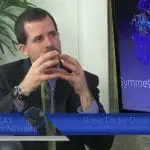One central question that proponents of biological evolution must answer is: How did the information in DNA arise? We might disagree on how much information is present in living things or even on how to quantify or define it, but pretty much everyone agrees that the DNA of living things contains information not found in non-living things and that complex organisms have more of it than simpler organisms.
So how did that genetic information get there? Can information be added, bit by bit, through unguided natural processes? That’s what evolution claims. Yet, thus far, this step by step addition of information has not been observed. Until it is observed, the idea of common ancestry of all life is merely conjecture.
Of course, even if we could show that there are some instances in which information is added by unguided natural processes, that would be necessary to support common ancestry, but not sufficient. In order to even begin to make a solid case for biological evolution, one must show three things. If even one of these prerequisites is false, the modern theory of evolution (i.e. universal common ancestry via unguided natural processes) cannot be true. If any one of them cannot be shown to be true, evolution remains unverified and thus belongs to the realm of speculation, not science.
1: It is possible to add biological information.
Richard Dawkins describes evolution with an analogy of “Mount Improbable” which looks like an impossibly steep cliff on one side, but can be climbed by tiny little steps up the back. This is the evolutionist’s concept of adding biological information in tiny steps, so that over time they add up to all the complexity we see among organisms today. However, Mount Improbable cannot be climbed unless it is, at some level, possible to go upward. If an organism only ever takes downward or level steps and cannot step upward, it will never get to the top, no matter how much time or how shallow the slope. Thus, in order to prove evolution, it is necessary (but not sufficient) to show that it is possible to add functional genetic information through unguided processes.
2: There are more upward steps than downward steps (or at least a way to get more upward steps than downward steps at least some of the time).
We know that genetic information is often corrupted and destroyed through mutation. We know that there are many, many harmful effects when an organism’s DNA is altered. In order for evolution to overcome this downward current toward catastrophic information loss, there must be an even stronger current upward (at least some of the time) in order to explain how the information was able to increase from that present in a tiny and simple organism to the information in a larger and more complex one.
Again, using the Mount Improbable analogy, it is impossible to get to the top by taking three steps downward for every step upward. There must be an overall trend toward increasing information. So even if there are a few examples of increasing information, they are not sufficient to prove evolution. If evolution is true, these upward changes must be the rule, not a rare exception.
3: There does exist a gradual genetic pathway that can be climbed in tiny, incremental steps.
In order for evolution to be true, not only does information have to be added over time, but each successive change must occur in a living organism and it must be conserved by being passed on to offspring. Thus, the change cannot kill the organism or seriously disable it, or the change will not be passed on. This must be the case for every step in the entire evolutionary sequence, no matter how small. At every step, there must be a functional organism. Thus, the changes must be gradual enough that the tiny upward steps (if they exist) can achieve each new level without killing or disabling the organism or impeding its ability to reproduce.
To use a simplistic analogy, if one tries to change from one word to another by changing one letter at a time (cat to cot to dot to dog, for example), there must, at every step, be an actual word that can be reached by changing one letter. In the Mount Improbable analogy, this means that there can be no upward jumps in the trail. If the maximum possible upward step is 6 inches, then there can be no 6 foot cliffs along the trail, or even 7 inch steps. If ever there is a step which requires more information than unguided evolution can provide, then evolution is falsified in that instance. It cannot account for the change in information in such a case.
—
The problem with these three points is that, not only have they not been demonstrated, they aren’t even adequately addressed by modern science. There has been a bit of discussion on Point 1, with a handful of examples that might show information increase, depending on the definition of information. However, even these are controversial and far from settled. There has yet to be shown any clear-cut examples of the addition of functional genetic information by unguided, natural means. There are plenty of examples of genetic change that benefits the organism, but being beneficial and showing an increase in information are not the same thing. While we have many instances of demonstrated change in organisms, it is not clear that these cases show the kind of change that is necessary to account for how the current genetic information in living things got there in the first place. Demonstrating a true gain-of-function mutation has proved very difficult, to say the least.
In addition to this, some cases of beneficial mutation appear to be non-random and thus may be a programmed response of the cell to change its DNA in response to specific conditions. This would be a directed mutation, not a random one. In such a case, no information has been added as the programming to cause this mutation was already in place.
So Point 1 above has not yet been conclusively proven. We don’t even have adequate evidence that upward evolution (spontaneously increasing information) is possible. But that’s just the first step.
Points 2 and 3 aren’t even discussed, much less demonstrated. In fact, there is good evidence that Point 2 is false. Simply the fact that there are only a few cases where an increase in information is even postulated, compared to the huge number of examples where genetic change is known to destroy information, suggests that the downward current is stronger and that genetic information is far more often destroyed than built.
Furthermore, Point 3 is usually just assumed without any discussion. The assumption appears to be that the theoretical gradual pathway of increasing complexity is real, without bothering to determine whether the proposed intermediate steps produce a functional living organism or whether or not there are information cliffs, so to speak, that cannot be climbed in small, gradual steps.
There is also some very good evidence that large jumps in information would be necessary. Many critics of evolution have pointed out examples of irreducible complexity in which a system exists that cannot be produced by gradual changes, but requires several parts to all be present and properly placed and oriented in order to produce any function at all. Such irreducibly complex systems would be examples of informational cliffs that cannot be produced by small, incremental steps.
Unfortunately, the fact that someone can imagine a gradual pathway of increasing information that results in a living organism at every step doesn’t mean it actually exists. Science requires more than mere speculation to make a valid theory. Until these issues are addressed and evidence is provided that all three prerequisites are true, it is more than premature to speak of evolution as fact – it is downright dishonest.
For further reading on this topic:
- Behe, Michael. The Edge of Evolution: The Search for the Limits of Darwinism. Free Press, 2008.
- Carter, Robert. Can Mutations Create New Information? http://creation.com/mutations-new-information
- Sanford, John. Genetic Entropy. 4th edition. FMS Publications, 2014.







